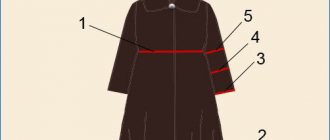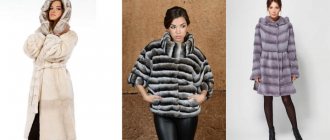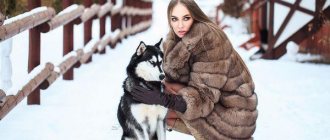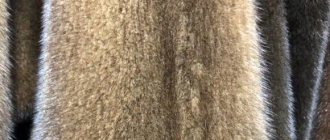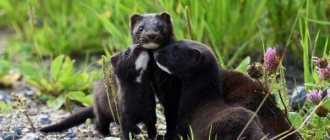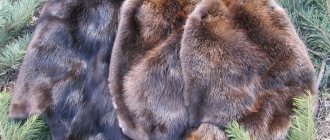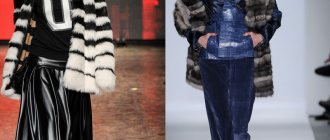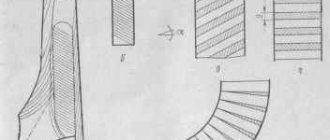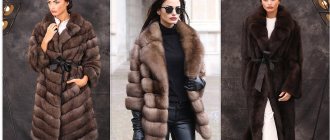The fur market pleases with its assortment, allowing you to choose a fur coat in accordance with your income level. The variety of models pleasantly surprises, but confuses the buyer. How to choose a fur coat? Which fur will last longer? Will the fur coat be warm enough? All these questions, one way or another, arise in the head of every person who wants to purchase such a valuable product.
For many years, mink, fox and sable were especially popular. Coats made from the fur of these animals are warm, practical and have an attractive appearance. But no one knows anything about marten fur. But this fur is not much inferior to them in its characteristics.
Pine marten fur
The pine marten has some similarities with the light sable. The skin is 420 – 580 mm long. Winter awn on rump up to 40 mm. The tail is approximately half the length of the body, has hair 2.5 times longer than on the body and darker than on the back; extends beyond the hind legs by at least a quarter of its length.
The spot on the throat is often of different shapes, well defined and comes in various shades - from light yellow to orange. The ends of the claws are not covered with hair.
The most common winter hair color is brownish-yellowish with smoky gray down. The summer coat is darker, sparser and coarser than the winter coat, with a brighter throat patch and darker down.
The size of the skin of pine martens varies, on average it is 6 – 6.5 dm2.
The whiter the fluff and the redder the tips, the worse the fur; The darker the tips of the awns and the grayer the down, the more valued the marten fur is.
Division into ridges, colors and varieties
Depending on their habitat, they are divided into ridges:
- Kuban Ridge - combines larger martens with thickened, lush, but slightly coarse fur. The tail is long and bushy. The size of the hair on the back and nape is almost the same.
- Northern Ridge (European part, except the Caucasus, Western Siberia) - unites silky martens with little fur and a short tail.
The most valuable skins:
- Murmansk - dark with soft silky fur.
- Leningradsky - dark with blue.
- Ural and West Siberian - light. The edit is often short, like sable skin.
- Vologda - smaller in size and with sparse hair.
In each ridge you can find skins with different shades of fur.
Based on color, skins are grouped into:
- dark blue;
- blue;
- dark sand;
- sand.
The darker the awn, the darker the fur usually is. There are partial and complete albinos, as well as two-shade ones (in the Urals).
Skins are divided into the following grades:
- winter - full-haired;
- early winter and late autumn - to a lesser extent full-haired with short fur;
- autumn - thin-haired with short hair.
Late winter in the process of thinning on the sides or belly; early spring with sparse fur and slightly thick skin; early spring ones with abrasion on the casing are classified as defective.
Defects and assessment of skin quality
Marten skin defects are divided into the following groups:
Skin quality assessment in %
Fur care
| Fur products require careful handling and regular cleaning. To care for R3 clothing made from natural marten fur, dry cleaning is best. It will get rid of the effects of precipitation, dust, dirt, grease, which make the fur dull and the pile brittle. After cleaning, things are combed so that the hairs lie one to one, the fur again becomes fluffy and voluminous. Additional polishing of the fur makes it “crumbly”, so that the product looks as good as new, as if on the first day after purchase. It is better to take your clothes to the dry cleaner in the spring, so that they go into storage clean and protected from pests - moths, lice beetles, carpet beetles. |
Mountain marten fur
The mountain marten has great individual variability. Its spine is coarser and sparser, the color of the down and lower zones of the spine is usually lighter, while the upper zone of the spine is darker than that of the pine marten. The throat patch is predominantly white, bifurcating on the chest. The soles are poor in hair. The tail of the mountain marten is longer and coarser, the ear is shorter and more rounded. The size does not differ from the forest one, the skin is heavier, the skin is rougher.
Division into ridges:
- Caucasian - combines skins with tall, thick, dense, slightly rough fur, and a bushy tail.
- Central Asian - combines smaller skins, softer fur, less hair, as a result of which the skin appears light.
They are distinguished by color:
- dark blue (chestnut with a blue tint);
- dark sand.
Skins are divided into the same 3 grades (similar to those of forest skins). As for late winter and spring skins, suction does not occur with them. Shedding is initially visible on the sides, then on the neck.
The defects and quality assessment of skins are the same as for forest skins.
The prepared pine and mountain marten skins are sorted into the same ridges, colors and grades as in the raw materials. Their signs are the same as in raw materials, with the exception, of course, of the color of the fur and the thickness of the skin.
Marten fur coat: why do women love it?
A marten fur coat is a rather exotic item, and therefore interesting for the buyer. It is not so often found on sale, and all because the marten is not specially bred in nurseries, like other animals, but is caught in nature. The high cost of a marten fur coat is also fully justified by the fact that this fur is one of the warmest.
A marten fur coat looks luxurious due to its long, thick and shiny pile . And what is important is that the fur coat does not lose this appearance over time, remaining as attractive for many years as at the time of purchase. Once you purchase a marten fur coat, you will deprive yourself of the worry of purchasing a new fur coat for a long period, which will significantly save your costs in the future.
Skinning a marten
The marten skin is removed using a tube with an incision along the rump. The fur on the head, paws and tail is preserved. The skins are degreased and cleaned of dirt and traces of blood, cuts of meat remains and veins, cartilage from the ears, small bones from the paws and vertebrae in the tail. They are straightened according to the shape with the fur facing out according to the rules. Preservation is carried out using the fresh-dry method.
Processing marten skins
The soft and mountain martens live in the USSR. The soft marten is also called the forest marten or yellow marten. Its skin is similar to the light skin of sable. The winter fur of the soft marten varies in color from sandy yellow to dark chestnut with bluish down; there is a light yellow or orange spot on the throat that runs like a wedge across the front legs. Pine martens differ from sables by having a fluffier and longer tail and less dense fur. The throat patch of martens is more sharply outlined (Fig. 21).
Rice. 21. Pine marten skin
The mountain marten is also called the stone marten, or the white marten. It differs from the forest one in having coarser hair, less dense fluff, and a dark brown tail. The throat patch of this marten is white, it continues with two white stripes on the front legs.
During fishing, bruises, tears, holes, and bald spots may form on the marten's skin. Holes occur when shooting martens, ruptures and bruises - from dog bites, blows from the arcs of a trap. Bald spots are formed if a shot animal, falling from a tree, clings to twigs. You cannot shoot martens with large shot, which will cause large wounds. Bleeding wounds should be covered with a cotton swab, soft cloth, moss or other hygroscopic material. To better preserve the fur of the skin from contamination with the blood of the hunted animal, it is recommended to wrap it in a soft cloth. Before removing the skin, the blood from the hair is washed off with warm water, and the wet hair is dried. If the skin is contaminated with resin, the latter is removed using a swab moistened with aviation gasoline or turpentine.
The marten skin is removed with a tube. Shooting can be done by hanging the carcass by the hind leg or placing it on your knees. On the front legs, skin incisions are made along the inside from the toes to the hock joint. The rump incision begins from the pad of one of the hind legs along the inside to the anus. Then the skin around the rectum is trimmed, a similar cut is made along the other hind paw, the skin is removed without a knife from the hind paws to the claws, the toes are cut off at the last joint, and the claws are left on the skin. After this, the skin is removed from the rump, the tail root is freed, the tail vertebrae are removed, and the tail tube is cut along the inside from the root to the end. Then the skin is removed from the body and front paws, leaving the claws with the last joint of the fingers on them. The skin is removed from the head using a knife. The skin of the lips, eyelids and nasal cartilage is trimmed. The cartilage of the ears is trimmed at the base, then removed from the auricles.
The removed skin is dressed by removing muscle cuts, fat and muscle film without a knife. Tears and holes are sewn up with white threads using a herringbone stitch so that the hair does not protrude from the side of the flesh. The dressed skin is put on a forked or wedge-shaped straightener with the flesh outward, and the folds are straightened. Strips of hygroscopic clean paper are placed on the insides of the front paws to prevent them from curling up when drying. Paper rolls or wooden planks are inserted into the paw tubes near the chest. The hind legs and tail are secured with nails to a wedge-shaped rule. If other rules are used, then these parts of the skin are fixed on special wooden planks, tying them with thin twine. Dry the skins at room temperature. Before the end of drying, remove any fat that has appeared on the flesh with a rag, remove the skin from the ruler, turn it inside out, put it back on the ruler and dry it completely. Before delivery to the procurement point, the skins are stored in a dark, cool, dry room, protected from insect pests and rodents.
Beautiful hats, collars, gorgets, and stoles are made from marten skins.
What is the difference between marten fur and sable fur?
The main differences between the sable and the marten, which is similar in appearance and lifestyle, are as follows:
- The sable's fur is slightly darker, silkier, thicker and softer than that of the marten; has some gray hair.
- The spot on the throat is smaller in size with various shades of yellow, and in a dark sable is barely noticeable.
- The top of the head of sables is slightly lighter than the ridge - martens have a similar color.
- The sable's tail is thick, soft, lush and does not appear to be the ends of its paws, like the skin of martens.
- Sable paws have large calluses covered with hair and sharpened claws. The marten, which climbs tree trunks, has large, sharp claws and delicate pads.
- Sables have slightly smaller ears than martens.
Not everything that looks like sable is gold
Luxury suits any woman
Martens and sables belong to the same genus. It is not surprising that their fur is so similar (In Canada, the marten is even called “European sable”). But the price of marten fur is lower, and therefore more affordable for the middle class of the population. In addition, it is perfect for harsh Russian winters: the dense, thick undercoat is not blown through and provides excellent protection from frost. Although marten is cheaper than sable, it is practically indistinguishable from it in appearance. Therefore, it is often used for counterfeiting in the fur world. However, the marten itself is included in a rather high price category. This is due to the fact that it is difficult to breed it artificially, and the bulk of the fur is obtained by hunting. Skins (30-40 cm long and 15-20 cm wide) are obtained by hunting with dogs, nets, and traps. Therefore, in order to collect high-quality raw materials for a long fur coat, you have to work hard.Marten fur products
The skins are used for gorgets, so they are made in a round form, preserving the paws, tail, ears and nose. When dressing, it is necessary to carefully treat the limbs and head. Lighter skins are sometimes dyed to resemble dark marten or sable using the riding method. In the pine marten, only the upper and middle zones of the awn are painted, while in the mountain marten (which is rarely painted), the lower zone of the awn and the down (not up to the skin) are colored as lighter downy, since the upper zone of the awn is usually quite dark.
The skins are also used for finishing, for collars, coats, stoles and gorgets. When cutting, the neck and paws are separated, making them into durable clawed and necked furs that go to the bottom of men's coats.
Origin of the species and description
Photo: Marten
The question of the origin of martens is complex and mysterious. To do this, it was necessary to conduct a whole detective investigation, determining the identity of all existing species:
- Sable.
- Pine marten.
- Stone marten.
- Ussuri marten (harza).
- Kidus (a mixture of sable and pine marten).
These species belong to the genus of martens and are close relatives of the genus of minks, weasels, rodents, wolverines, ferrets, bandages, badgers, even sea and river otters. These animals have adapted well to life on all continents where people live freely. You can meet them in the Taiga, Europe, Africa, South and North America, and indeed everywhere.
They descended from a common ancestor who may have lived 35 million years ago. The above species belong to the mustelid family and are related to the family of dogs, raccoons, bears and cats. It’s hard to imagine, but they really were similar to each other, because they represented a group of predators.
More mysterious is the common ancestor of the miacids, which inhabited planet Earth about 50 million years ago! It is believed to be the forefather of all known mammalian predators. He was small, flexible, with a long tail and a large brain, which indicates superior intelligence at that time. After 15 million years, some representatives began to acquire the characteristics of martens, and from that moment their history began.
Mink
The mink coat is particularly beautiful because the fur consists of hairs of almost the same length. Mink wears well and is also characterized by good plasticity.
Let's compare mink and marten: due to the fact that mink skins are relatively inexpensive, due to the fact that they are beautiful, elastic and warm, mink coats are the most common. In addition, there is always a good assortment of such fur coats on the fur market.
Marten has beautiful fur, reminiscent of sable. The cost of a marten coat is several times higher than a mink coat, simply because the skins are obtained by hunters.
Each type of fur coat is good, you can safely buy each one for the cold season, the main thing is that they suit your figure and emphasize your beauty.
Who is this marten?
The habitat of predators of the mustelid family covers the forest zones of the American continent and Eurasia. The animal is considered wild and rarely lives in captivity, so there are no specialized fur farms.
Biologists distinguish 8 types of martens:
- American (Martes americana) - found throughout the continent.
- Ilka (Martes pennanti) is a forest dweller, common in the coniferous forests of North America.
- Stone (Martes foina) - lives mainly in Eurasia, also found in Russia.
- Forest (Martes martes) - is a European resident.
- Nilgiri (Martes gwatkinsii) - found in the southern regions of India.
- The sable (Martes zibellina) is a typical inhabitant of the taiga forests of Russia.
- Kharza (Martes flavigula) is mainly a resident of Asian countries; it also lives in the Primorsky and Khabarovsk Territories.
- Japanese (Martes melampus) - in addition to Japan, found in Korea.
The body of the animal is oblong (on average 45-55 cm), lean, covered with fluffy hair of medium length, weight can reach 2 kg. The muzzle is sharp, the ears are large, triangular in shape. The paws are short, strong, and have sharp and strong claws. The most noticeable part of the body is the long bushy tail.
For the most part, martens live in forests and avoid people. They feed on small birds and mammals and often destroy nests. In the warm season, they hunt in their “own” area, and in winter, in search of food, they explore adjacent territories and even landfills. In Russia there are: sable, harza, pine and stone martens (the latter sometimes terrorize poultry farms and cause a lot of trouble to rural residents).
Features of character and lifestyle
Photo: Animal marten
As previously stated, pine martens spend most of their lives in trees. They move well along them, jumping at a distance of 4 meters. Females and males have their own territory, which can overlap, where they build or use abandoned shelters of squirrels or birds. To identify their own lands, they use the secretion secreted by the anal glands. They sleep during the day and hunt at night.
The main feature of the sable is its developed hearing and keen sense of smell. Able to cover long distances, which indicates excellent endurance. The sable's calling card is its interesting way of communication. Most often, they purr gently; if you need to warn about danger, they crackle, and during mating games they meow affectionately.
The way of life of Kidas depends on the genetics that the parents passed on: a flatter marten or a sable, as well as what their role was in their upbringing. This is a very amazing, rare and little-studied animal, which at a young age can be found with different representatives of the mustelid family: sable and pine marten.
Stone martens hunt at night, but during the day they sleep in piles of stones and rock crevices, and not in trees, like forest martens. This species is closer to people because they often use stables or attics as shelters and hunt chickens and pigeons raised by farmers. Outside the mating season, they lead a solitary life, not wanting to intersect with their own kind.
The Kharza stands out because it hunts in a pack and is a fairly social animal. In addition, she is very strong and is able to cope with the cubs of a large animal, for example, a deer or a wild boar. While pursuing the victim, he cleverly takes shortcuts, crossing snow debris along branches. It does not fall under the snow because it has wide paws.
What does a marten eat?
Photo: Animal marten
Forest martens are omnivorous. They hunt, preferably at night, for squirrels, hares, voles, birds and their eggs. Sometimes they eat snails, frogs, insects and carrion. In city parks they fight against water rats and muskrats. In autumn they feast on fruits, nuts and berries. They catch fish and small insects. Sometimes hedgehogs attack. In late summer and early autumn it prepares food for the winter.
The sable, like its hybrid kidas, also keeps the forest at bay. But, unlike the pine marten, it gives priority to hunting on the ground, which is why chipmunks and moles predominate in its diet. Large males are capable of killing a hare. Among birds, hunting predominates on sparrows, partridges and wood grouse - their chances of surviving an encounter are zero.
Hunting for squirrels turns into a real thriller - sables chase their prey through the trees, periodically jumping from a height of 7 meters.
Stone martens are also natural hunters, with excellent eyesight, hearing and smell. Thanks to this, they are able to track down any animal that seems edible to them. They differ from previous representatives of the mustelid family in their courage and cruelty: they penetrate dovecotes with chicken coops, where they destroy all the prey.
Kharza is the strongest hunter of the family. Runs quickly and jumps up to 4 meters. It hunts rodents, birds and does not even disdain grasshoppers. Quite often chases sables. Eats nuts and berries in small quantities to maintain sufficient levels of vitamins in the body. Loves to eat musk deer.
